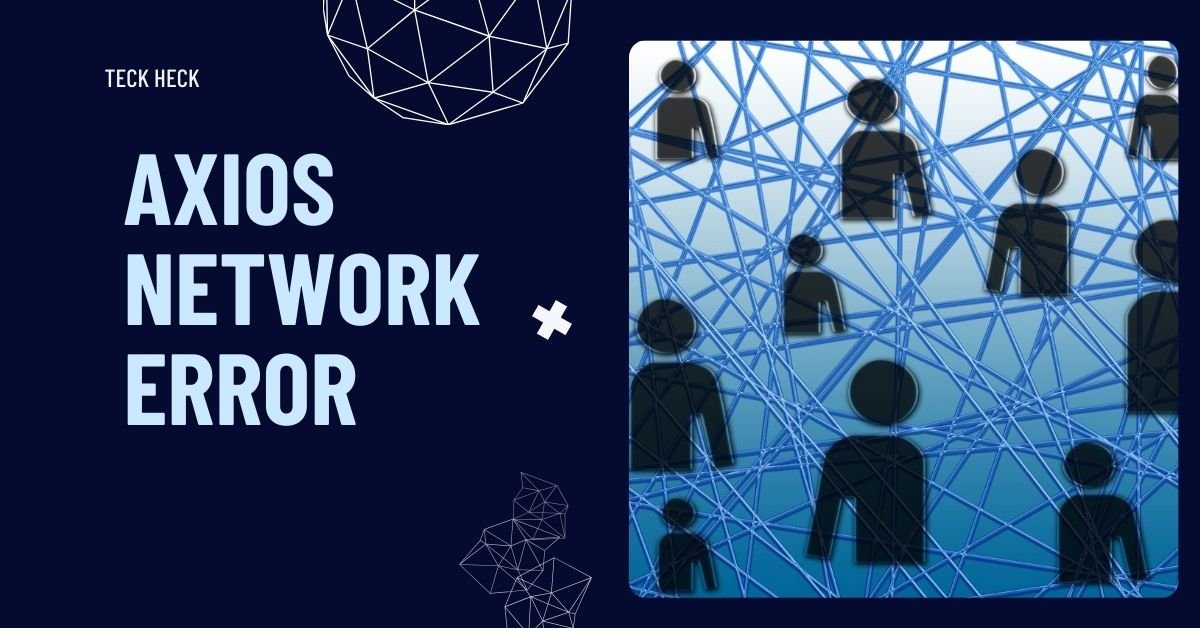
How would you handle a “ Axios Network Error when no response is received from the server?
This comprehensive post discusses typical reasons and fixes for the ” Axios Network Error” that occurs in Axios:
Axios Network Error: Typical Reasons and Solutions
Axios is a well-known JavaScript library for sending HTTP requests, and developers frequently run into the “Axios Network Error” when using it. Because it does not always give precise information about what went wrong, this error might be annoying. However, you can solve the problem more rapidly if you know the typical reasons and how to troubleshoot them.
- Axios Network Error: What is it?
When your HTTP request is unsuccessful or the server does not answer appropriately, Axios usually displays a network error. Numerous factors, including wrong URLs, CORS problems, network connectivity issues, or timeouts, could be at blame for this.
Typically, Axios raises a Network Error when:
Because there is no internet connectivity, the request cannot be fulfilled.
Because of DNS problems, an incorrect server address, etc., the server cannot be reached.
Security regulations are in effect (CORS).
Request limits or timeouts are exceeded.
- Axios Network Error Common Causes
2.1. The wrong URL
An improper URL is among the most basic reasons for a network issue. This could be as simple as using the incorrect protocol (http:// instead of https://) or making an error in the domain or path.

Solution: Verify the URL twice to make sure it is accurate and that the server can be reached. For instance:
To check if the server is reachable, you may also try opening the URL in your browser or use programs like curl or Postman.
Problems with Cross-Origin Resource Sharing (CORS) 2.2
In order for the server to accept cross-origin requests (those coming from a different domain or port), CORS headers must be present. The browser will block the request if these headers are missing or incorrectly specified, and you will frequently encounter a “Network Error.”
Solution: Verify that the server-side CORS setup contains the necessary headers, such as:
In order to get around CORS problems during development, you might need to employ a proxy server if you do not have control over the server.
2.3. Problems with Network Connectivity
Axios may not finish a request if there is a bad or erratic internet connection. Connectivity issues, client-side issues, or server-side issues may be the cause of this.
Solution: To make sure your network is operational, check your internet connection and attempt to access other websites or APIs.
To check if the server is reachable, you may also use curl or Postman.
2.4. Timeout Request
Axios may raise a timeout error if the request takes too long to finish (for example, because of sluggish network conditions or server-side latency).
Solution: You can raise Axios’ timeout setting if you think there may be timeouts:
By doing this, the request will have additional time to finish before expiring.
2.5. Firewall or Proxy-Blocked
A Axios Network Error may occur if your requests to external servers are being blocked by a corporate proxy or firewall.
Solution: You must examine your proxy configuration. You can set Axios to use a proxy if you are working in a Node.js environment:
Make sure that your browser is set up to use the corporate network proxy if you are using one.
2.6. Problems with SSL/TLS
SSL/TLS problems may arise while communicating with a server via HTTPS. This may occur if the SSL certificate on the server is self-signed, invalid, or has expired.
Solution: Verify that the server’s SSL certificate is up to date.
To fix the certificate you can also get in touch with the server administrator.

- How to Troubleshoot and Address Axios Network Error Issues
It is critical to record the entire error when you run into a network issue in order to determine what went wrong. Axios offers multiple methods for managing faults and obtaining comprehensive insights.
3.1. Managing Axios Errors
Here’s how to record and capture comprehensive error information:
In Axios a ” Axios Network Error ” usually indicates that there were problems with connectivity or server settings that prevented the HTTP request from being completed. Resolving this error requires an awareness of its causes and solutions, which can take many different forms. An explanation of the “Network Error” in Axios is provided below, along with comprehensive details on potential causes and troubleshooting techniques.
- What is an error in the Axios Network Error?
When Axios cannot finish an HTTP request because of connectivity problems, it generates an Axios Network Error. There are several situations in which this could occur, including:
The server cannot be reached.
There was no reply from the server.
The request was prohibited by CORS limitations.
A timeout is in effect.
SSL certificates are problematic.
Usually, the error is raised when Axios fails to get a response from the server or runs into a problem when submitting the request.
- Axios Network Error Common Causes
2.1. A URL that is incorrect or unavailable
Axios will not be able to make the request and will throw a network error if the request URL is incorrect (for example, a mistake, improper domain, or a protocol mismatch).
Problems with Cross-Origin Resource Sharing (CORS) 2.2
The destination server must permit cross-origin requests (requests from one domain to another) by sending the proper CORS headers. A Network Error will appear and the browser will deny the request if CORS is not set up correctly on the server.

2.3. Issues with Network Connectivity
Axios may be unable to fulfill the request due to a network connectivity problem. You may get a network error if the server is down, you are offline, or your network is slow.
Verify if:
You have a functional internet connection.
Other websites or services are available to you.
2.4. Timeout Request
Axios will generate a timeout error if a request takes too long to respond (due to server latency or network problems); in certain situations, this error may also manifest as a network fault.
2.5. Problems with the server (down or misconfigured)
Axios will not get a response and will raise a network error if the server is unavailable, incorrectly configured, or not accepting requests.
- How to Find and Fix Errors in the Axios Network Error
In order to determine the underlying reason of a network error, it is critical to record as much information as you can. To aid in debugging, Axios offers helpful features inside the error object.
3.1. Comprehensive Error Details
To find out what went wrong, you can access several characteristics of the error object. Here’s ways to record specific details about the error:
dentifying the Error’s Cause
Verify the URL: Make sure you are attempting to reach the right API endpoint.
Verify the status of the server: Use programs like Pingdom, cURL, or Postman to see if the server can be reached.
Look for CORS: Make that the server accepts cross-origin requests before sending them. To see if CORS headers are present, check the Network tab in the Developer Tools section of the browser.
Check for timeouts. Examine whether the request took too long, and if so, think about raising the timeout value.
Verify SSL/TLS: Make sure the SSL certificate is valid if you are utilizing HTTPS.
.2. Retry Requests That Failed
Network problems may occasionally be temporary (e.g., a brief loss of connection). To automatically retry unsuccessful requests, you might put in place a retry mechanism.
Axios Retry can be used to manage Axios Network Error automated retries:
You might need to utilize JSONP for cross-origin queries or put up a proxy if you do not have control over the server.

4.4. Track Requests on the Network
To keep an eye on network requests and check for problems with the request headers or server response, use the browser developer tools (found in Chrome or Firefox).
Network Tab: Verify the headers, response time, and request status code.
Console Tab: Check for any logged issues linked to SSL or CORS.
- In conclusion
Incorrect URLs, connectivity issues, CORS problems, timeouts, and other issues can all contribute to the Axios Network Error. You may rapidly identify and fix the problem by closely examining the error message and applying the debugging strategies covered.
Important items to look for:
Verify that the API endpoint is accurate.
Effectively manage retries and timeouts.
Look for SSL/TLS and CORS problems.
To fully examine the error, use extensive logging.
You may reduce the frequency of network errors and increase the dependability of your Axios requests by adhering to best practices for error management.


